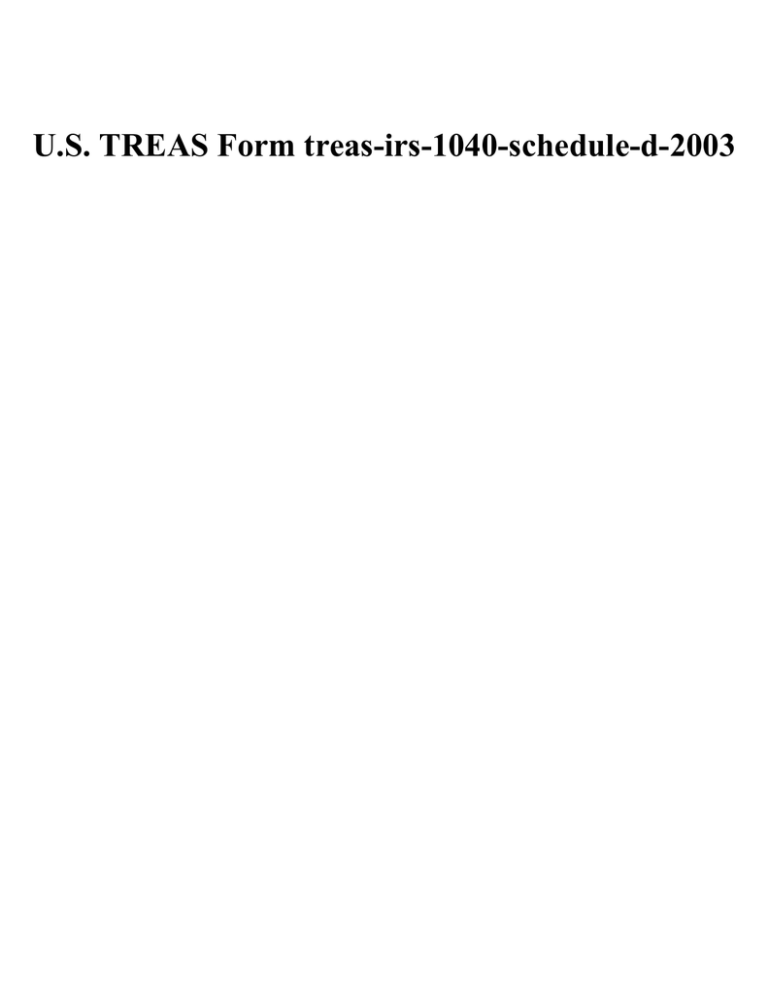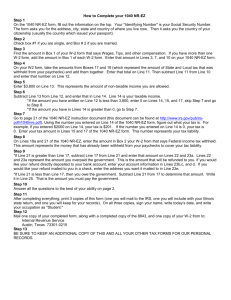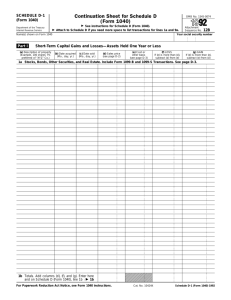U.S. TREAS Form treas-irs-1040-schedule-d-2003
advertisement

U.S. TREAS Form treas-irs-1040-schedule-d-2003 SCHEDULE D (Form 1040) Department of the Treasury (99) Internal Revenue Service OMB No. 1545-0074 Capital Gains and Losses 䊳 Attach to Form 1040. 䊳 䊳 Use Schedule D-1 to list additional transactions for lines 1 and 8. Name(s) shown on Form 1040 Part I 2003 See Instructions for Schedule D (Form 1040). Attachment Sequence No. 12 Your social security number Short-Term Capital Gains and Losses—Assets Held One Year or Less (a) Description of property (Example: 100 sh. XYZ Co.) (b) Date acquired (Mo., day, yr.) (c) Date sold (Mo., day, yr.) (d) Sales price (see page D-6 of the instructions) (e) Cost or other basis (f) Gain or (loss) for (g) Post-May 5 gain (see page D-6 of the entire year or (loss)* the instructions) Subtract (e) from (d) (see below) 1 2 Enter your short-term totals, if any, from 2 Schedule D-1, line 2 3 Total short-term sales price amounts. 3 Add lines 1 and 2 in column (d) 4 Short-term gain from Form 6252 and short-term gain or (loss) from Forms 4684, 6781, and 8824 5 Net short-term gain or (loss) from partnerships, S corporations, estates, and trusts from Schedule(s) K-1 6 Short-term capital loss carryover. Enter the amount, if any, from line 8 of your 2002 Capital Loss Carryover Worksheet 7a Combine lines 1 through 5 in column (g). If the result is a loss, enter the result. Otherwise, enter -0-. Do not enter more than zero b Net short-term capital gain or (loss). Combine lines 1 through 6 in column (f) Part II 4 5 6 ( ) ( 7a 7b ) Long-Term Capital Gains and Losses—Assets Held More Than One Year (a) Description of property (Example: 100 sh. XYZ Co.) (b) Date acquired (Mo., day, yr.) (c) Date sold (Mo., day, yr.) (d) Sales price (see page D-6 of the instructions) (e) Cost or other basis (f) Gain or (loss) for (g) Post-May 5 gain (see page D-6 of the entire year or (loss)* the instructions) Subtract (e) from (d) (see below) 8 9 10 Enter your long-term totals, if any, from Schedule D-1, line 9 9 Total long-term sales price amounts. 10 Add lines 8 and 9 in column (d) Gain from Form 4797, Part I; long-term gain from Forms 2439 and 6252; and long-term gain or (loss) from Forms 4684, 6781, and 8824 Net long-term gain or (loss) from partnerships, S corporations, estates, and trusts from Schedule(s) K-1 Capital gain distributions. See page D-2 of the instructions Long-term capital loss carryover. Enter the amount, if any, from line 13 of your 2002 Capital Loss Carryover Worksheet 14 15 Combine lines 8 through 13 in column (g). If zero or less, enter -0­ 15 16 Net long-term capital gain or (loss). Combine lines 8 through 14 in column (f) Next: Go to Part III on the back. 16 11 12 13 14 * 11 12 13 ( ) Include in column (g) all gains and losses from column (f) from sales, exchanges, or conversions (including installment payments received) after May 5, 2003. However, do not include gain attributable to unrecaptured section 1250 gain, “collectibles gains and losses” (as defined on page D-8 of the instructions) or eligible gain on qualified small business stock (see page D-4 of the instructions). For Paperwork Reduction Act Notice, see Form 1040 instructions. Cat. No. 11338H Schedule D (Form 1040) 2003 Schedule D (Form 1040) 2003 Part III Page 17a Combine lines 7b and 16 and enter the result. If a loss, enter -0- on line 17b and go to line 18. If a gain, enter the gain on Form 1040, line 13a, and go to line 17b below b Combine lines 7a and 15. If zero or less, enter -0-. Then complete Form 1040 through line 40 Next: ● If line 16 of Schedule D is a gain or you have qualified dividends on Form 1040, line 9b, complete Part IV below. ● Otherwise, skip the rest of Schedule D and complete the rest of Form 1040. 18 If line 17a is a loss, enter here and on Form 1040, line 13a, the smaller of (a) that loss or (b) ($3,000) (or, if married filing separately, ($1,500)) (see page D-7 of the instructions) Next: ● If you have qualified dividends on Form 1040, line 9b, complete Form 1040 through line 40, and then complete Part IV below (but skip lines 19 and 20). ● Otherwise, skip Part IV below and complete the rest of Form 1040. Part IV 19 20 21 22 23 24 25 26 27 28 29 30 31 32 33 40 41 42 43 44 45 46 47 48 49 50 51 52 53 17a 17b 18 ( ) Tax Computation Using Maximum Capital Gains Rates If line 16 or line 17a is zero or less, skip lines 19 and 20 and go to line 21. Otherwise, go to line 19. 19 Enter your unrecaptured section 1250 gain, if any, from line 18 of the worksheet on page D-7 20 Enter your 28% rate gain, if any, from line 7 of the worksheet on page D-8 of the instructions If lines 19 and 20 are zero, go to line 21. Otherwise, complete the worksheet on page D-11 of the instructions to figure the amount to enter on lines 35 and 53 below, and skip all other lines below. 21 Enter your taxable income from Form 1040, line 40 22 Enter the smaller of line 16 or line 17a, but not less than zero 23 Enter your qualified dividends from Form 1040, line 9b 24 Add lines 22 and 23 25 Amount from line 4g of Form 4952 (investment interest expense) 26 Subtract line 25 from line 24. If zero or less, enter -0­ 27 Subtract line 26 from line 21. If zero or less, enter -0­ Enter the smaller of line 21 or: ● $56,800 if married filing jointly or qualifying widow(er); ● $28,400 if single or married filing separately; or ● $38,050 if head of household If line 27 is more than line 28, skip lines 29–39 and go to line 40. Enter the amount from line 27 Subtract line 29 from line 28. If zero or less, enter -0- and go to line 40 31 Add lines 17b and 23* � Enter the smaller of line 30 or line 31 Multiply line 32 by 5% (.05) If lines 30 and 32 are the same, skip lines 34–39 and go to line 40. 34 Subtract line 32 from line 30 35 Enter your qualified 5-year gain, if any, from 35 line 8 of the worksheet on page D-10 36 37 38 39 2 Taxable Gain or Deductible Loss 28 29 30 32 33 34 36 Enter the smaller of line 34 or line 35 Multiply line 36 by 8% (.08) 38 Subtract line 36 from line 34 Multiply line 38 by 10% (.10) If lines 26 and 30 are the same, skip lines 40–49 and go to line 50. 40 Enter the smaller of line 21 or line 26 41 Enter the amount from line 30 (if line 30 is blank, enter -0-) 42 Subtract line 41 from line 40 43 Add lines 17b and 23* Enter the amount from line 32 (if line 32 is blank, enter -0-) 44 45 Subtract line 44 from line 43 46 Enter the smaller of line 42 or line 45 Multiply line 46 by 15% (.15) 48 Subtract line 46 from line 42 Multiply line 48 by 20% (.20) Figure the tax on the amount on line 27. Use the Tax Table or Tax Rate Schedules, whichever applies Add lines 33, 37, 39, 47, 49, and 50 Figure the tax on the amount on line 21. Use the Tax Table or Tax Rate Schedules, whichever applies Tax on all taxable income. Enter the smaller of line 51 or line 52 here and on Form 1040, line 41 *If lines 23 and 25 are more than zero, see Lines 31 and 43 on page D-9 for the amount to enter. 37 39 47 49 50 51 52 53 Schedule D (Form 1040) 2003


